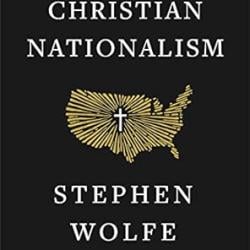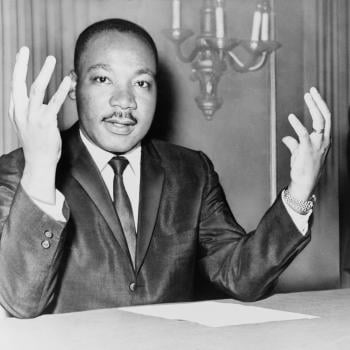A Blast from the Theological Past That’s Still Relevant: Augustus Hopkins Strong’s “Ethical Monism” (“There is but one substance—God.”)
I realize that this blog, like most, does not draw a large audience by delving into dusty, old theological issues. Unfortunately, most religious blog readers are interested only in “what’s happening now” including controversies, personalities, scandals and the latest “big ideas” (that usually turn out to be recycled ones from the past).
However, some of my blog followers express appreciation that here I at least occasionally talk about something more than those current interests of the masses and bring up some influential theological proposal from the past that may have been forgotten and that may be “too deep” for Christians not willing to put their minds to work.
Often my thoughts here are stimulated by commenters who seem confused about theology. It’s often the case that what they say or ask reminds me of a long-forgotten theological dispute or theologian who wrestled with the issue in some creative way. I want to help people see two things: 1) most questions in theology have been thought about quite thoroughly already (there’s nothing really new under the theological sun), and 2) there are resources in the history of theology they might find helpful. Of course, I also want to help them work through their confusion to clearer thinking (if not my way of thinking!).
Recently here some visitors to my blog have been advocating some version of what philosophers and theologians call “monism.” Of course, they might not be thorough-going or consistent monists, but their insistence that the human soul/spirit is “part of God” (a reaction to my advocacy of the doctrine of “creation out of nothing”) is implicitly monistic—at least as regards the spiritual realm.
Monism has many variations, but the underlying idea of all monisms is that there is really only one substance and that all plurality represents appearances of that one substance. Monism is one answer to one of the most ancient of all philosophical problems: “the one and the many.” The opposite of monism is metaphysical pluralism—that there is no “one” underlying the many. Both monism and pluralism admit of numerous variations and the philosophical literature is full of attempts to create hybrids. But most hybrids incline one direction or the other—either toward unity of all reality or diversity and plurality of all reality.
The nineteenth century was a time period in which monism was “in the air” in European and American philosophy and theology. The distant inspirations were thinkers like Spinoza who posited a rational monism in which God is all there is and everything is some manifestation of God. The Romantic Movement, including American Transcendentalism, was enchanted with monism without always going to Spinoza’s extreme. Emerson’s “Oversoul” was one version of monism that attempted to do justice also to variety in reality. William James reacted against monism and embraced pluralism. For him reality is a “blooming, buzzing confusion” without underlying metaphysical unity. In Emerson the “one” was winning over the many; in James the “many” was winning over the one. Neither were extreme versions of the metaphysical visions that attracted them.
Theologians could not help being influenced by these philosophies; philosophy has always been theology’s main conversation partner—at least until recently when sociology and economics has replaced it in some liberation theologies. (Which is not to say even liberation theologies can escape philosophy altogether!)
One surprising example is evangelical Baptist theologian Augustus Hopkins Strong (1836-1921). Strong was a member of a very influential Rochester, New York family. If you visit Rochester (which I have several times) you will see the Strong name everywhere on institutions. The fabulous Mount Hope Cemetery where many members of the Progressive Movement are buried (including Susan B. Anthony and Frederick Douglass) features a large Strong family crypt or mausoleum in which Augustus is buried. Augustus was professor of theology at Rochester Theological Seminary, the oldest Baptist seminary in North America. If I recall correctly he was at one time its principle (what would today be called “dean”). Around the turn-of-the-century he was without doubt one of the most influential theologians in North America. His massive Systematic Theology: A Compendium (three volumes) was published in 1907 and has been in continuous publication (Judson Press) ever since. At 1056 pages of fine print (not including indexes!) it remains one of the most exhaustive and thorough Christian systems of theology ever published by an American. It was used as the main textbook in systematic theology courses in evangelical and Baptist seminaries for decades. It was for free church evangelicals and Baptists (overlapping categories) what Charles Hodge’s Systematic Theology was for Reformed and Presbyterian seminaries.
When I was attending a Baptist seminary in the 1970s I asked my main professor of systematic theology to name the theologian and system of theology that is most generally representative of Baptist theology. (I was not Baptist yet but was considering becoming Baptist.) Without hesitation he named Strong and his Systematic Theology. Then he said “But beware of his ‘ethical monism’.” When I asked about that he suggested I read evangelical theologian Carl F. H. Henry’s published Boston University dissertation Personal Idealism and Strong’s Theology (Van Kampen Press, 1951). I did read Strong and tried to read Henry’s book but, at the time, was so taken with Emil Brunner’s Dogmatics (our main textbook in systematic theology courses) that I found both extremely dry and difficult to understand. But I have kept both in my library and have turned to Strong’s theology many times when I needed a good outline of a doctrine or just some quick information about an arcane subject.
Some years ago I happened to buy a collection of essays by Strong in a used bookstore. The title is Christ in Creation and Ethical Monism (Roger Williams Press, 1899). I’ve been slowly reading through it—essay by essay. Strong came across in Systematic Theology as a hard core Calvinist but that is not the case in Christ in Creation. The essays (some were lectures and addresses delivered by Strong at Rochester and other places) breathe an entirely different spirit than Systematic Theology. They don’t seem like they were written by the same person! For example, one outstanding essay in Christ in Creation is “God’s Self-limitations” in which Strong argues that God limited himself in creation for the sake of creatures’ freedom. Another is “Openness of Mind”—Strong’s 1895 commencement address at Rochester Seminary. It’s a model of evangelical open-mindedness, what I have called “postconservative evangelicalism”—not empty mindedness or openness to everything but willingness to consider that something you’ve always been taught and that has always been believed could possibly be wrong. It is clearly a warning against incipient fundamentalism.
My point in all this is twofold. First, there have been great, creative theologians, American and evangelical, who, during their lifetimes and afterwards, were extremely prolific and influential who have been virtually forgotten—sometimes I fear to our loss. We have very short memories; even such an important evangelical theologian as Bernard Ramm is being completely forgotten. He was one of my teachers and a formative influence on me (as on my friend Stanley Grenz). Many of the contemporary debates about “the Bible and science” were settled by Ramm (in terms of principles, not specifics) in his groundbreaking The Christian View of Science and Scripture (Eerdmans, 1954).
Second, monism, or a conservative Christian version of it, has been tried by one of America’s great, if forgotten, theologians who was also an evangelical Baptist. I’m not convinced, however, that Strong was successful in his use of monism. I think he fell into contradictions, but that’s for another time.
So what is “ethical monism” according to Strong? In the background is Spinoza’s monism, the belief that God is all there is and everything is some form or manifestation of God. This idea cast a strong influence over the minds of nineteenth century intellectuals who struggled mightily with it. It was a solution to the philosophical problem of the “one and the many” that exalted God and was a corrective to the growing pluralism that seemed supported by science and pragmatism. What better metaphysical compliment can one pay to God than to say he’s all there is? How better to emphasize the immanence of God and even address the issue of evolution than to regard everything as God’s constant and continuing creation?
And yet Strong was not satisfied with Spinoza’s or any other already existing form of theistic monism. He set out to create his own that would do justice to 1) the transcendence of God, 2) the freedom of creatures, and 3) ethics including the reality of sin and evil. One of the main problems he saw in traditional monisms, especially Spinoza’s, was that they tended to reduce evil to illusion.
In Christ in Creation Strong devoted three chapters to “ethical monism.” In “Summary of Monistic Doctrine” he said “Let me sum up my monistic doctrine by saying: there is but one substance—God.” (45) He immediately continues with many strong qualifications. “This is not pantheism, for pantheism is not simply monism, but monism coupled with two denials, the denial of the personality of God and the denial of the transcendence of God.” Then he relies heavily on God’s self-limitations in creation to explain the possibility and then reality of the appearance of sin and evil in God. This paragraph is perhaps the most telling in pointing out why Strong’s ethical monism does not ultimately “work”:
There are no second causes in nature. The forces and laws of nature are the habits or generic volitions of God. Finite spirits are the only second causes, for only they have freedom. Having freedom, they do not reproduce in particular acts a generic volition of God; they may set their wills in opposition to God. That these finite spirits are circumscriptions of the divine substance and have in them the divine life shows the infinite value of their being; but it also shows the dreadfulness of their sin when they morally sunder themselves from God. While deterministic monism [e.g., Spinoza’s] puts both man and God under the law of cause and effect, and so makes impossible the sin on the part of man which requires redemption and the free grace on the part of God which provides redemption, Christian or Ethical Monism holds to self-determination in both God and man and maintains the reality and guilt of sin as well as the possibility and reality of grace. (46)
Even this valiant attempt to rescue monism from determinism and to put some “distance” between God and man in monism ultimately fails. It raises more questions than it answers and the answers it does provide (e.g., to the problem of evil) undermines the monism.
However, Strong shows that even a great Christian intellectual can be confused and still be Christian. In my opinion, and that of most Christians throughout history, creation out of nothing is important. Like the doctrine of the Trinity it lies somewhere in the liminal space between dogma and doctrine, but it is a man-made doctrine, not the gospel itself or revealed truth itself. The problem is that any denial of it leads inevitably into confusion and contradiction or heresy (if not idolatry).












